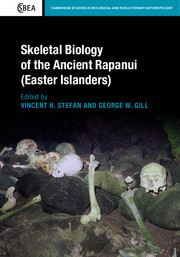Book contents
- Frontmatter
- Contents
- List of contributors
- Acknowledgements
- 1 Introduction: Research overview
- 2 Review of Polynesian and Pacific skeletal biology
- 3 Chronology and Easter Island prehistory
- 4 A descriptive skeletal biology analysis of the ancient Easter Island population
- 5 Craniometric variation of the prehistoric Polynesians and Rapanui
- 6 Rapanui non-metric cranial traits
- 7 Intra-island discrete cranial trait variation
- 8 Continuous non-metric characteristics of the early Rapanui
- 9 Rapanui dental morphology
- 10 Pelvic variability and sexual dimorphism in prehistoric Rapanui
- 11 Genetic affinities of the Rapanui
- 12 Archaeogenetics and paleodemographic estimation of founding populations: Features of residential geography on Rapa Nui
- 13 Evidence for injuries and violent death
- 14 Demographic analysis of modified crania from Rapa Nui
- 15 East Polynesian and Paleoindian parallels and contrasts in skeletal morphology
- 16 Rapanui origins, relationships, and warfare: A summary in theoretical context
- References
- Index
4 - A descriptive skeletal biology analysis of the ancient Easter Island population
Published online by Cambridge University Press: 05 December 2015
- Frontmatter
- Contents
- List of contributors
- Acknowledgements
- 1 Introduction: Research overview
- 2 Review of Polynesian and Pacific skeletal biology
- 3 Chronology and Easter Island prehistory
- 4 A descriptive skeletal biology analysis of the ancient Easter Island population
- 5 Craniometric variation of the prehistoric Polynesians and Rapanui
- 6 Rapanui non-metric cranial traits
- 7 Intra-island discrete cranial trait variation
- 8 Continuous non-metric characteristics of the early Rapanui
- 9 Rapanui dental morphology
- 10 Pelvic variability and sexual dimorphism in prehistoric Rapanui
- 11 Genetic affinities of the Rapanui
- 12 Archaeogenetics and paleodemographic estimation of founding populations: Features of residential geography on Rapa Nui
- 13 Evidence for injuries and violent death
- 14 Demographic analysis of modified crania from Rapa Nui
- 15 East Polynesian and Paleoindian parallels and contrasts in skeletal morphology
- 16 Rapanui origins, relationships, and warfare: A summary in theoretical context
- References
- Index
Summary
Introduction
This general description of the ancient Rapanui, based upon skeletal characteristics, addresses a number of dimensions. Craniometrics are utilized to provide insight into the general appearance of these prehistoric people, such as cranial and facial size and shape. Facial reconstructions on both male and female crania have also been produced, and provide additional details regarding appearance. These “living faces” have also yielded surprising results relating to the continuity of some facial characteristics from ancient times right on up into the modern era, as expressed among the living Rapanui people.
More extensive craniometrics, along with DNA research, have been our best line of inquiry into the origins and relationships of the prehistoric Easter Islanders, but that subject will be the focus of subsequent chapters of this book (especially Stefan, Chapter 5; Hagelberg, Chapter 11), and not the purpose of this descriptive chapter. The only craniometric features to be discussed here beyond the very basic descriptive ones are a few that have real significance in defining population variation, in forensic and other contexts. These are things like the quite useful dimensions relating to shape of the palate and size and shape of the mastoid processes, and also those pertaining to nasal projection. Some select measurements of the mandible have also been included.
Postcranial metrics of the femur and humerus are discussed here because of their importance in defining sexual dimorphism and population differences that are useful in forensic science contexts, and some other areas of inquiry. Calculations of living stature of these prehistoric people have been made from lengths of long bones. Adult femoral and humeral head diameters are also presented. These male and female averages differ from those published in the textbooks of human osteology and forensic anthropology based upon the usual samples of White and Black populations. Such variations among the Polynesians are important differences that not only will be fully described here but also need to eventually be noted in the broader osteological literature. A high degree of femoral platymeria constitutes another important difference documented here between the ancient Rapanui and large well-documented samples of Black and White peoples.
- Type
- Chapter
- Information
- Publisher: Cambridge University PressPrint publication year: 2016



